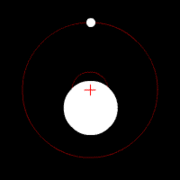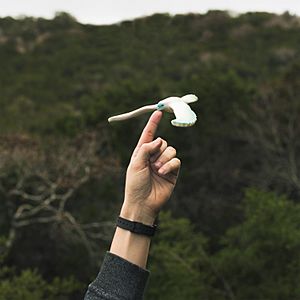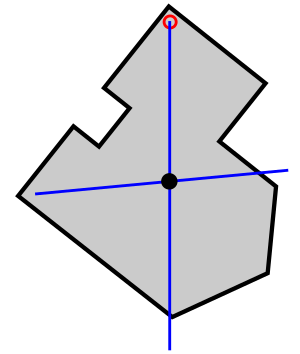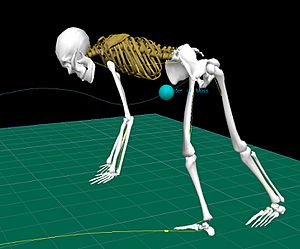Center of mass facts for kids
The center of mass is a special point in an object or a group of objects. Imagine you could balance an object perfectly on your finger. The spot where it balances is its center of mass. It's like the average position of all the mass in an object.
In physics, we use the center of mass to understand how objects move. It's a bit like imagining all the mass of an object is squished into this one tiny point. This helps make calculations simpler, especially when studying how things move or spin.
Sometimes, the center of mass can be outside the object itself! Think of a horseshoe or a donut. Their center of mass is in the empty space. For a group of separate objects, like the planets in our Solar System, their combined center of mass might not be inside any one planet.
The center of mass is super useful for understanding how things like planets move. It helps scientists figure out their momentum and how they orbit.
Contents
How We Found the Center of Mass
The idea of the center of mass was first thought of by a smart Greek scientist named Archimedes. He lived a very long time ago. Archimedes figured out that if you have weights on a lever, the turning force (called torque) is the same as if all the weights were moved to one special point – their center of mass.
Archimedes was the first person to find ways to locate this important point in different shapes.
Finding the Center of Mass
You can find the center of mass of an object in a few ways. If an object has a perfect shape, like a cylinder or a sphere, its center of mass is usually right in the middle. For example, a perfectly round ball has its center of mass at its very center.
For Flat Objects
To find the center of mass of a flat, irregular object, you can do an experiment:
- Hang the object from one point.
- Hang a plumb line (a string with a weight) from the same point. Draw a line along the string.
- Now, hang the object from a different point and repeat the step.
- The point where your two lines cross is the center of mass!
If an object has a complicated shape, you can break it down into simpler shapes. Find the center of mass for each simple part. Then, you can combine these to find the center of mass for the whole object. Even objects with holes can be figured out this way!
Real-Life Uses of Center of Mass
The center of mass is important in many areas, from sports to flying!
In Sports
- Sports Cars: Engineers design sports cars to have a very low center of mass. This helps the car stick to the road better and turn more easily.
- High Jump: When high jumpers do a "Fosbury Flop", they arch their back over the bar. This clever trick means their body goes over the bar, but their actual center of mass might pass under the bar!
In Airplanes and Helicopters
The center of mass is super important for how an aircraft flies.
- Airplanes: For an airplane to be safe and stable, its center of mass must be in a specific spot. If it's too far forward, the plane might be hard to control. If it's too far back, it could become unstable and difficult to fly.
- Helicopters: When a helicopter is hovering, its center of mass is always directly under its main rotor. When it flies forward, the center of mass shifts a bit.
In Space

In astronomy, the center of mass is called the barycenter. It's the point where two or more space objects balance each other as they orbit.
- Earth and Moon: The Moon doesn't orbit the exact center of the Earth. Instead, both the Earth and the Moon orbit a point between them. This point, their barycenter, is about 1,710 kilometers (1,062 miles) below Earth's surface.
- Pluto and Charon: For objects with similar masses, like Pluto and its moon Charon, the barycenter is actually outside both of them! They both "dance" around this empty point in space.
See also
 In Spanish: Centro de masas para niños
In Spanish: Centro de masas para niños
Images for kids





